#witch's herbal tea
Text
Ok so I think that I want to write for my au but it's a highly linear story and the mini fics that I write would be entirely out of order because I can't focus on anything.
I have an idea for how I'm going to write it but I need help.
Keith keeps a diary. He hides it in a magically locked drawer in his room.
What if I write Keith's diary entries and keep a post with all the links for easy enough reading?
Would you guys like that? I'm interested in trying it out but I would love opinions on this concept.
73 notes
·
View notes
Text
HERBS for Digestive Health🌿
To help improve and ease digestive disorders and issues.
Ginger
widely used to treat nausea, bloating and soothe digestive issues
Turmeric
used for digestive weakness and inflammation
Chamomile
helps settle inflammation and anxiety related stomach issues
Fennel
great to reduce bloating, cramping and relax stomach muscles
helps break down food
Cinnamon
helps regulate circulation, blood sugar levels, and digestive function
Rosemary
supports healthy digestive functioning
Increasing your consumption of some of these even slightly could make a big difference over time! Should be used with caution.


#digestion#digestivehealth#gut health#herbs#medicinal herbs#herbal treatments#herbal tea#herbal#natural healing#health#healthy#healing#spirituality#witch community#witchblr#spiritual#herbs and spices#plants and herbs#tips#kitchen tips#natural medicine#stomach issues#stomach problems#digestive disorders#chamomile#ginger#fennel#rosemary#inflammation#digestive system
321 notes
·
View notes
Text
Herbal tea basics -
Herbal teas can help with a wide range of health issues, depending on the type of tea and the specific properties of the herbs used.
Here are a few examples:
Digestive issues: Ginger, peppermint, and chamomile tea can help soothe an upset stomach, relieve bloating, and aid digestion.
Anxiety & stress: Chamomile, lavender, and lemon balm tea are known for their calming and relaxing properties, and can help reduce feelings of anxiety and stress.
Insomnia: Valerian root, passionflower, and chamomile tea can help promote relaxation and improve sleep quality, making them useful for treating insomnia.
Cold & flu symptoms: Echinacea, elderflower, and ginger tea can help boost the immune system, reduce inflammation, and relieve symptoms of colds and flu.
Menstrual cramps: Ginger and chamomile tea can help relieve menstrual cramps and other symptoms of premenstrual syndrome (PMS).
Headaches: Peppermint and ginger tea can help relieve headaches and migraines, thanks to their anti-inflammatory and pain-relieving properties.
It's important to note that while herbal teas can be helpful for many health issues, they are not a substitute for proper medical care.
If you have a serious health condition or are taking medication, it's always best to talk to your healthcare provider before using herbal teas or other natural remedies.
#herbal teas#herb magick#green witch#grimoire#witchblr#witchcore#witchcraft#witchlife#white witch#beginner witch#witch tips#spirituality#book of shadows
793 notes
·
View notes
Photo
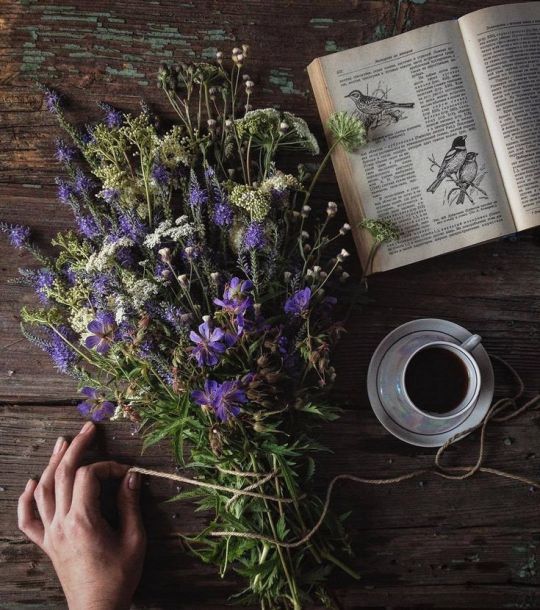
🔮 Witchy Goth & Pagan Shop 🔮
Use code “TUMBLR” for 20% off
#witchblr#witchy#witchcraft#occult#occultism#pagan#paganblr#herbs#herbal witch#green witch#tea witch
823 notes
·
View notes
Text
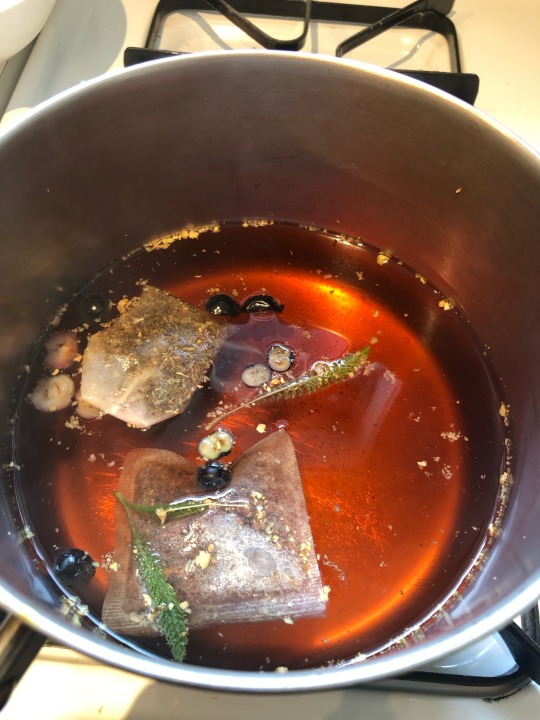
Menstrual Cramp Relief Tea 🫖
1 bag of raspberry tea
1 bag of chamomile & lavender tea
6 halved blueberries
A couple sprigs of yarrow
A tbsp Minced ginger root
I put it in about 32 ounces of water and I am drinking the whole thing. I just strain it but you can definitely put the ingredients in a tea bag or ball :)
#holistic#alternative#aesthetic#nature#period cramps#remedies#pagan#goddess#green#tea#green witchcraft#herbal remedies#oc#green witch
220 notes
·
View notes
Text

#khajiit metaphysical#not mine#stolen from facebook#witchblr#witchcraft#cottagecore#witchcore#witch#tea recipes#tea#herbs#herbal witch#kitchen witch#potions
83 notes
·
View notes
Text
Because that last post got me thinking about it:
- Herbalism is an entirely unregulated profession
- Anyone can call themselves an herbalist with no qualifications at all
- Herbal “schools” are also largely unregulated
- Many witchcraft books on herbalism, even some popular ones, are created by the author just googling “(plant) magic” and citing whatever random blogspot post they find first.
- The medicinal effects of many, if not most, herbs touted for medicinal purposes have not been proven. Homeopathy defies every principle established by science and medicine and does not work.
Some herbs can kill if you touch them. Countless others can cause irreparable organ damage if ingested in medicinal amounts. Yes, even the ones safe for culinary use. Yes, even “safe” homeopathic dilutions.
Research this shit like your life depends on it, because it does.
#witchcraft#mine#research#green witchcraft#herb witch#witchy blog#witch#garden witch#herbalism#green witch#tea magic
86 notes
·
View notes
Text
Herbalism in Times of Turmoil
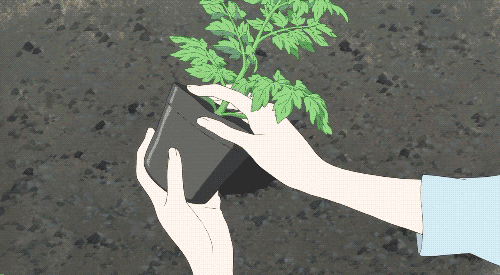
I've recently returned to my roots (pun intended) in folk herbalism to supplement the work I'm doing with my therapist. It wasn't an intentional thing -- in our current round of EMDR, we've uncovered some deeply buried trauma, and bringing that trauma to the surface has shaken the foundations of how I see myself and the world around me. I feel very raw and vulnerable. I feel disoriented and fragile.
I find myself drawn to plant medicine as I navigate this trauma with the help of my therapist. I think a part of me longs for the sympathetic magic of plants -- by taking them into my body, maybe I, too, can become firmly rooted, supported by the earth and nourished by the sun. Maybe I can relearn the magics of stillness and connection. Maybe I can reintegrate into the earth's cycles of death and rebirth.
Some of the plants I'm partnering with in this work are old friends. Others are new allies, recommended by professional herbalists for the type of trauma I'm processing. All of them are supportive in different ways, and all of them have important lessons.
Obviously, I am working with herbs as a compliment to the work I'm doing with a professional mental health counselor, not as a replacement for medical/psychological care. I recommend you do the same, especially if dealing with complex trauma. Even if money is tight, you may be able to get free or low-cost counseling through local social services, nonprofits, university hospitals, etc.
How I Work with Herbs
As an animist, I see working with herbs both as physical medicine and as a working relationship with the spirit of the plant. I don't like to say that I "use" herbs, because that implies that they are just tools. When I say I "work with" an herb, what I mean is that I am partnering with that plant as a living, thinking being that has kindly chosen to support my healing process. I try to honor that relationship in every part of my herbalist craft.
One way I do this is by verbally thanking the plants that I consume as medicine. If I'm drinking a cup of linden tea, I'll say something like, "Thank you, linden, for aiding in my healing today."
I try to use herbal preparations that allow for a sensory experience to help me connect with the plant spirit(s). I don't like taking capsules full of powdered herbs, because that doesn't allow me to see, touch, smell, or taste the plant. I like teas because they allow for a much more intimate connection with the plant's spirit, and I use tinctures when I feel like I need more concentrated medicinal compounds.
I'm a witch who loves plants, but when I'm working with herbs internally, I do not choose them based on their magical or spiritual correspondences. When choosing herbs, I look for quality scientific studies that prove their medicinal benefits, but honestly a lot of plant medicine hasn't been sufficiently studied yet. Because of this, I also look at the way plants are viewed in traditional healing modalities like Western herbalism, Ayurveda, Traditional Chinese Medicine, etc.
While I don't pick them based on their magical properties, I do think studying how these plants are used in magical practices can add an extra layer to my work with them. This helps me to have a more nuanced, deep, and complex relationship with the plant's spirit.
And of course, I always research contraindications and drug interactions before using an herb. For example, I don't recommend Saint John's Wort to anyone taking any kind of pharmaceutical medication because it really messes with the way your body processes your meds. It's also important to research how herbs might interact with other herbs and supplements you're already taking -- that's also a type of drug interaction!
I also try to remember that when we're moving through grief or processing trauma, this changes the way herbs (and drugs, for that matter) affect our bodies. I highly recommend the book The Trauma-Informed Herbalist by Elizabeth Guthrie to learn more about this.
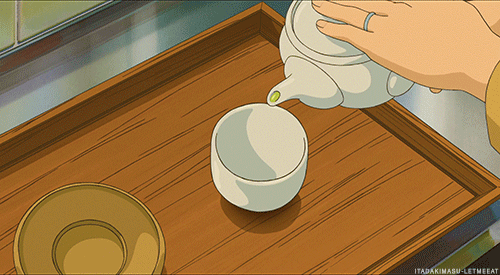
My Herbal Allies
These are the herbs I'm taking focusing my practice on right now:
Ashwagandha and Tulsi are two plant friends that I love pairing together. They're both adaptogens, meaning they can help manage the body's stress response, and come to Western herbalism by way of Ayurveda. I've been working with both of these plants for years, and although they do have different uses, I think they work really well together.
Ashwagandha is really helpful as a pick-me-up for the endocrine system (the system that produces hormones) and nervous system. I find that it has a very grounding effect and is especially helpful for when I feel overwhelmed or burned out. It's a great ally for building resilience when you feel like there's just way too much going on and have no idea how you're going to handle it all. It has a very bitter taste, so I usually add it to coffee or another very bitter beverage.
Tulsi, also called Holy Basil, is a lot more gentle and laid-back than ashwagandha, at least in my experience. It's one of my go-to herbs when I need emotional support. According to herbalists Katja Swift and Ryn Midura, "Tulsi has traditionally been the herb of choice for 'stuck emotions,' whether that's depression or PTSD or just a case of the grumpies." It has a delicious taste somewhere between basil and mint, and I love preparing it as a hot tea. This is one of my favorite herbs right now.
In Ayurveda, ashwagandha is classified as a Rasayana, which means it rejuvenates the body and can promote long life. It is also a Bhalya, meaning it promotes strength, and a Vajikara, which means it promotes healthy sexuality. Tulsi is one of the most valued herbs in Ayurveda and is even called the most sacred plant on earth in the Vedic Puranas. It increases sattva (light, clarity), uplifts the spirit, promotes joy and harmony, and increases prana (vital energy; similar to the concept of chi in China). They're sometimes used together because they're believed to support each other and enhance each other's effects.
I add ashwagandha and tulsi tinctures to my morning coffee and to other hot beverages throughout the day. I also really like tulsi as a tea, and tulsi tea is one of my go-to tools for replenishing my energy after a long day of tarot readings. That being said, I'm considering changing the way I consume these herbs to be more in line with traditional Ayurvedic practices, but I need to do more research first.
Cannabis is, honestly, one of my personal miracle workers, which is a little bit ironic because I also think it's waaaaay overhyped in the wellness industry right now. Cannabis is not a cure-all, and it is not recommended for everyone. There are several different types of cannabis, and each type has its own medicinal uses. For example, the cannabis I use in my personal practice is hemp, which is legally defined as cannabis with little to no THC, meaning it does not produce a high. Marijuana, the type of cannabis with THC, is powerful medicine for some people, but because of how my body and brain work, I personally don't use it. While marijuana use may be illegal depending on where you live, hemp is legal in most places.
I started working with cannabis several years ago to help manage anxiety and insomnia, but nowadays I mostly work with it to help with inflammation and chronic pain.
I find that my body really holds on to trauma in the form of tension, inflammation, and chronic pain. When my trauma response is triggered, I usually feel it as tension or pain, especially in my hips, pelvis, and lower back. I find cannabis really helpful for that stored trauma. It doesn't make the pain go away, but it helps me feel into it and navigate through it. I also find cannabis is really good at relaxing my body and helping me let go of that stored up trauma, almost like unclenching a fist.
Cannabis was historically used throughout the ancient world for divination and religious ritual. It's associated with connection to the spirit world, and may have been used in magical practices like the Norse practice of seidr. Scott Cunningham says hemp is associated with love spells and with Midsummer.
My favorite way to work with cannabis is with a cannibidiol (CBD) isolates. Since I live in a place where THC is illegal and have some health conditions that don't play well with THC, I like CBD isolates because I'm able to make sure I'm getting a THC-free product. I add CBD to my coffee along with tulsi and ashwagandha, and I feel like it helps me process the caffeine better. I also notice rapid relief for joint and nerve pain, anxiety, and intrusive thoughts after drinking this brew.
Meadowsweet is a new plant friend for me. I actually first came across meadowsweet when I was researching handfasting herbs -- it's a traditional inclusion in British handfasting and wedding ceremonies, and was historically used as a "strewing herb," which means it was sprinkled on the ground. It's also a traditional flavor in mead, and in fact the name "meadowsweet" comes from its traditional use in mead-making. (I actually have a batch of meadowsweet mead fermenting right now!)
In herbalism, meadowsweet is prized because it contains salicylates, which can be used to make salicylic acid, the main ingredient in aspirin. This makes it great for pain, especially pain caused by inflammation. It's also great for your digestive system, which makes it a powerful ally if, like me, you suffer from the dreaded "anxiety tummy."
Meadowsweet is a very summer-y plant for me, and its energy reminds me of summer sunshine. It's a plant that reminds me to find joy in the little things in life, and has a very hopeful vibe. This is a plant I associate with both Midsummer and Lughnasa. It's a great friend for when you just need a little sweetness in your life.
On a more physical level, I combine meadowsweet with cannabis, ashwagandha, and tulsi to manage chronic pain rooted in trauma. And, of course, for keeping the anxiety tummy at bay.
In European magic traditions, meadowsweet is associated with love, peace, and joy. Interestingly, Scott Cunningham also talks about the use of meadowsweet for protection from thieves.
I add meadowsweet tincture to my morning coffee along with ashwagandha, tulsi, and CBD. I also really enjoy it as a hot tea, and I think the flavor blends really well with tulsi.
Linden is another new friend for me, but I am obsessed. I don't think I've ever worked with an herb that feels this gentle, supportive, and nourishing to the soul. Katja Swift and Ryn Midura of the Holistic Herbalism Podcast call linden "a hug in a mug," and I think that's a perfect description of how it feels.
In Western herbalism, linden is most often used for heart conditions and to restore the cardiovascular system. However, it also works as a nervine, which means it has a calming effect on the nervous system. It can provide gentle relief for anxiety, tension, and even everyday stress. In Herbal Medicine for Beginners, Swift and Midura even recommend linden to "mitigate the side effects of drying, stimulating medications like Adderall and Ritalin." It is also recommended for nerve pain and damaged nerves.
Linden is wonderful medicine for the heart, both the physical heart and the emotional heart. I really do feel an improvement in my mood when I work with linden. It's soothing and uplifting at the same time.
Magically, linden is strongly associated with protection. It's also associated with love, good luck, and preventing insomnia. Scott Cunningham mentions carrying linden to prevent intoxication.
My favorite way to work with linden is by drinking it as a tea. It tastes similar to chamomile, but a little less fruity. I drink several cups throughout the day, especially when I feel like I need to unwind or calm down.
Rose is one of my favorite flowers. Maybe that makes me basic, but I really do love this plant. The scent of rose has been one of my favorite scents since I was very small -- I remember going to Catholic mass with my mom and praying with my own rose-scented rosary!
We usually think of rose as a decorative flower or an ingredient in perfume, but it also has culinary and medicinal uses. It's used topically to treat skin issues by promoting the growth of new skin cells and to treat rashes and eczema. It can also help soothe gut problems. Rose is also relaxing and anti-inflammatory.
In magic rose is associated with love and romance (duh), divination, healing, fast luck, protection, and connection to the divine. Cunningham recommends it for calming "personal stress and household upheavals" and says the flowers attract fairies. This might be because I was raised Catholic, but rose feels like a very sacred plant to me. In Catholicism it's associated with the Virgin Mary and with some other saints like St. Therese of Lisieux, but I personally use rose more in ancestor work (especially when working with queer ancestors) and for attracting friendly spirits in general.
Right now, my favorite way to work with rose is in aromatherapy. The smell of fresh roses is so uplifting, and it makes me feel like I'm surrounded by gentle, loving protection. I'm sure there are probably health benefits to working with the pure essential oil, but real rose essential oil is VERY expensive, so I use a mild rose-scented perfume instead. (I'm very sensitive to scents and often get headaches from artificial fragrances, but right now I'm wearing Pacifica Beauty's Persian Rose perfume and I haven't had any issues with it.)
Sources:
Herbal Medicine for Beginners by Katja Swift and Ryn Midura
Queering Herbalism, 3rd edition, compiled by Toi of the Herbal Freedom School
The Trauma-Informed Herbalist by Elizabeth Guthrie
Cunningham's Encyclopedia of Magical Herbs by Scott Cunningham
All episodes from the first season of The Trauma Informed Herbalist podcast, but especially the two-part series, "How Trauma Changes Us"
"Herbs for Psychological First Aid" from The Holistic Herbalism Podcast
"Herbs & the Holidays: Emotional Support" from The Holistic Herbalism Podcast
"Working With Herbs For Chronic Pain" from the Holistic Herbalism Podcast
"The Centuries-Old Secrets of Gender-Affirming Herbalism" by Leah Kirts
"How To Incorporate Hemp In Your Materia Medica" by Heather Saba
"Cannabis: Potent and Versatile Medicine" by Sue Sierralupe & Candace Hunter
"An Ayurvedic perspective on Marijuana" by Shilpika Devaiah
"Who shouldn't use medicinal cannabis?" by Corinne Hodgson
#herbalism#plant medicine#plant magic#green witchcraft#green witch#trauma#trauma healing#complex trauma#ashwagandha#tulsi#ayurveda#cannabis#cannawitch#meadowsweet#linden#rose#tea magic#tea witch#kitchen witchcraft#kitchen witch#queer herbalism#witchblr#witch#herbs#animism#animist herbalism#long post#my writing#mine
423 notes
·
View notes
Text
Interesting..i will be trying this method 🙍

#tea aesthetic#tea witch#herbal tea#witchcraft#witchyvibes#witch community#witchblr#green witch#witchy#witchy tips#paganlife#witches of tumblr#pagan witch#baby witch#paganblr#cottage witch#cottage life#witch blog
436 notes
·
View notes
Text
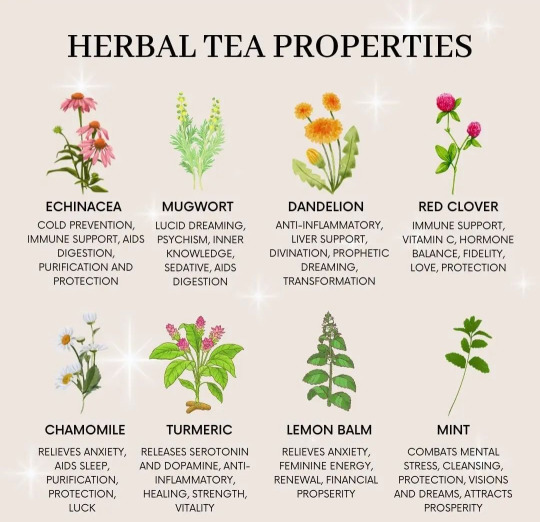
🖤✨
#herbal tea#herbal tea properties#green witch#lunar witch#witchyvibes#gemini#witchy blog#magic#witchcraft#baby witch#herbs
29 notes
·
View notes
Text
Ok so about Pidge in Witch's Herbal Tea (WHT):
Any pronouns but often defaults to feminine when referring to themself [I'm projecting]
Keith affectionately refers to them as Pigeon
He grew up with Keith because Matt and Shiro were besties so they were besties by proxy
A fuck around find out typa bitch when it comes to experiments (Good thing they have good healthcare)
Created a homunculus as an experiment and is now her lab hand/pet (Rover)
#I'm going through and giving plot details about side characters because I can#Witch's Herbal Tea#vld pidge#pidge gunderson#pidge voltron#pidge holt
21 notes
·
View notes
Text
A beginner guide to tea blending 🌿
⚠️This is meant to be a simple guide based on my own research and experience, by all means, educate yourself further and double check everything before proceeding!⚠️
First, define your intention or goal for this blend: what medicinal properties do you want to extract from these plants? You should know the medicinal value and effects of each plant separately before trying them out together and finding out how they interact with each other. Similarly, taste all the herbs separately before putting them together to get a better tasting blend.
You’ll have to find a good balance between:
the right dosage of each herb to get their medicinal value,
the taste of said herbs to your liking,
the right dosage to avoid any possible side effects.
The herbs that cause the main desired effect should take up to 70% of the blend.
One type of effect can be based on which system you want to work in (if the herbs all have similar positive effects on immune, circulatory, digestive, or other systems, like for example calming nerves or easing digestion). The other would be a nourishing effect (if the effects on each system cancel each other and thus you’re only taking in the nutrients, like minerals and vitamins, of the herb). The first kind would all have herbs that work together towards a common goal, the second would have effects that counteract each other so you only absorb their nutrients.
Then you’ll have supporting herbs, up to your 20%, that either boost the good medicine, and/or relief possible side effects of the main herbs.
Depending on the effects each plant has on your body, you’ll want them to boost each other or counteract each other. Also take into account if it’s an overall cooling or warming effect, boosting or slowing down metabolism, if it dries or moistens the tissues with minerals and fluids, and whether it’s relaxing or constricting/toning in tissues aswell.
Last should be possible catalysts. These are optional, but recommended. That would be up to 10% of stimulant herbs that boost metabolism or enhance the overall effects of the others, to really get all the good stuff into your body.
Some good examples of catalysts are ginger root, cayenne or licorice root, but be careful with licorice as it can be toxic in high amounts!
To give you an example of how I’d put everything into practice: if my goal is to make a tea blend that’s toning, rich in minerals and vitamins and strengthens the immune system, I’d use 5 parts stinging nettle, 2 parts lemon balm (for the main effects), 2 parts thyme (supporting), and 1 part ginger root (catalyst), then sweeten to taste. Parts can be grams, teaspoons, or smaller measures, depending on how much blend you want to prepare. If you’re going to try this blend, do this exercise: research each plant, it’s medicinal value and side effects, and you’ll find out why I put them together!
Also, I personally love the taste of stinging nettle, yet someone else may prefer to use 5 parts of lemon balm and 2 parts of stinging nettle instead and get a slightly different result, more soothing to the nervous system, try it for yourself and always check for the effects and right dosages. I normally measure each part as grams, and this formula gives me around 2-3 liters of infusion, depending on how strong you make it. That is, using dry herbs, if you’re using fresh plant material you’ll need more grams. Normally 1 teaspoon of dry herb equals 1 tablespoon of fresh herb, or 1 part dried equals 3 parts fresh, but there may be slight differences between each plant depending on how much water it contains.
Finally, write everything down! The formula, how it worked for you and what it tastes like.
Thanks for reading ♡

#herbalism#rootwork#black herbalist#native herbalist#indigenous herbalism#indigenous herbalist#tea blending#beginner guide#herbalism 101#tea 101#tea blends#tea blend 101#medicinal teas#medicinal herbs#medicinal plants#green witch#green witchcraft#green magic#curanderismo#cottagecore#goblincore
357 notes
·
View notes
Text
Randomly ranting ~
When I started my witchcraft practice, I got into the herbal part, and I used rosemary for EVERYTHING and still do, love rosemary prosperities and in general in my witch eat practice (the herb is dried when I get it from the store).
HOWEVER rosemary in my herbalism practice NASTY I cannot take it alone, cannot stand the smell, and it’s just weird to work with.
It full on took me for a whirl, I was taking by surprise. Big surprise. And I’m just like at a standstill, eye staring contest with it right now. I don’t know how to feel about it.
Okay thank you for coming to my red talk rant about rosemary.😂💜also if you had the same problem please comment because I’d like to know why rosemary is like that😭because the smell is atrocious when it is fresh or freshly dried to me…🥲
#witchblr#witchcraft#witch#baby witch#witchcraft community#witch community#magic#magick#witchcraft blog#nature#herbal remedies#herbs#herbal witch#herbalism#herbal medicine#medicinal herbs#herbal tea#herbalist
20 notes
·
View notes
Text
Herbal teas for stress
Here are some herbal teas that are known for their stress-reducing properties:
Chamomile tea: Chamomile is a popular herb known for its calming effects. Drinking chamomile tea can help relax the body and mind, reducing stress and promoting a sense of tranquility.
Lavender tea: Lavender has soothing properties and a pleasant aroma. Lavender tea can help alleviate anxiety, promote relaxation, and reduce stress levels.
Lemon balm tea: Lemon balm is a member of the mint family and has been used for centuries to promote relaxation and reduce stress. Drinking lemon balm tea can help calm the nervous system and uplift the mood.
Passionflower tea: Passionflower has long been used as a natural remedy for anxiety and stress. Drinking passionflower tea can have a calming effect and help relieve tension.
Ashwagandha tea: Ashwagandha is an adaptogenic herb that helps the body adapt to stress and promotes a sense of calm. Consuming ashwagandha tea can help reduce stress levels and promote overall well-being.
Holy basil tea: Holy basil, also known as Tulsi, is a herb with adaptogenic properties. Drinking holy basil tea can help reduce stress, promote relaxation, and enhance mental clarity.
Remember, while herbal teas can be beneficial for stress reduction, it's important to address the underlying causes of stress and practice healthy coping mechanisms.
If you're experiencing chronic stress or anxiety, it's recommended to consult with a healthcare professional for proper guidance and support.
#herbal teas for stress#herbal tea#witchblr#witchcore#witchcraft#witchlife#white witch#beginner witch#witch tips#grimoire#green witch#herb magick#spirituality#book of shadows#teas
282 notes
·
View notes
Photo

🔮 Witchy Goth & Pagan Shop 🔮
Use code “TUMBLR” for 20% off
#tea witch#witchy#cottage witch#cozy#cozy aesthetic#cottagecore#cozy cottage#cottagecharm#cottage aesthetic#herbal witch#earth witch#pagan
470 notes
·
View notes
Text
Hey, if you're stuck in the smog rn (so, most of my East Coast compatriots) here's a quick lung detox tea to help you get the gunk out of your lungs.
- 4-5 teaspoons of mullein
- 1-2 teaspoons of ground ginger
- 1-2 teaspoons of hibiscus leaf
- 1 teaspoon of marshmallow root
- Enough honey and lemonade to make it palatable (it'll be gross so don't be afraid to go crazy)
The important part is the Mullein and Ginger, so if you don't have any of the other ingredients it'll taste nasty but it'll do it's job plenty well. This hibiscus and marshmallow helps with the fatigue that comes with inhaling smog. This will make you cough! This is good!
Good luck and be safe out there!!
#witchblr#herbalism#witches of tumblr#tea#tea recipe#how do I tag this for max reach#the man conjures
68 notes
·
View notes